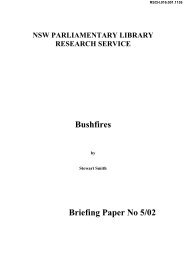Chapter 4 - Warnings - 2009 Victorian Bushfires Royal Commission
Chapter 4 - Warnings - 2009 Victorian Bushfires Royal Commission
Chapter 4 - Warnings - 2009 Victorian Bushfires Royal Commission
You also want an ePaper? Increase the reach of your titles
YUMPU automatically turns print PDFs into web optimized ePapers that Google loves.
<strong>Warnings</strong><br />
274<br />
4.213 The CFA’s opposition to the use of sirens is recorded in the report. In this context, the report noted<br />
that statewide CFA messaging does not always suit local issues: ‘It does not consider people such as<br />
recreational bushwalkers who may not have any warning about an approaching bushfire and those residents<br />
(children and older people) who are not aware of safety procedures or who are not able to leave their homes<br />
on days of total fire ban’. 275<br />
4.214 It appears that the tension referred to above, which may exist between the statewide bushfire preparedness<br />
policy and local interest in early warning systems that suit a particular community, continues to plague the<br />
development of local solutions. One of the lessons from February <strong>2009</strong> is that greater weight ought to be<br />
given to communities’ desires to fashion warning systems appropriate to their location and their needs.<br />
4.215<br />
Mr Esplin described the Ferny Creek siren in the following way:<br />
They are a unique community in the sense of, firstly, their preparedness for fire; secondly in their accepting<br />
that they have chosen to live in a place in the State that is particularly beautiful most of the time but<br />
particularly high risk in a very small percentage of time. They accepted that risk and understood that<br />
they had a responsibility to take steps themselves to protect themselves and their community. They were<br />
prepared to take on responsibility for the siren which they have done and maintained to this time. 276<br />
4.216 The community in Ferny Creek use their siren as a ‘contribution to promoting appropriate bushfire survival<br />
behaviour’. It is not promoted as a trigger to evacuate, but rather it prompts residents to ‘access further<br />
sources of information’ 277 and to activate defensive actions.<br />
4.217 The progress of the Ferny Creek fire alert siren was further considered in a subsequent evaluation report:<br />
Community Alerting For Bushfire — A Local Solution For a Local Need: The Ferny Creek Fire Alert Siren<br />
Follow-up Evaluation 2002 conducted by the OESC. 278 The follow-up evaluation confirmed that the fire alert<br />
siren is now ‘an established element within bushfire preparedness planning and response. The fire alert siren<br />
is one link in a chain of communication being used and accessed by community residents’. 279<br />
4.218 The evaluation noted that a belief remains in the emergency management sector that sirens encourage<br />
residents to unsafely leave their homes if a bushfire threatens. The evaluation has in fact shown that, with<br />
appropriate community education and communication ‘the role of the alert siren can be incorporated into<br />
appropriate and safe planning and decision making’. 280<br />
4.219 This example provides robust evidence that a siren can be part of a successful program for bushfire<br />
preparedness and that, if properly understood and implemented, a protocol for the use of a siren does not<br />
undermine statewide policies such as ‘stay or go’, which is further discussed in <strong>Chapter</strong> 7. The success of<br />
the project is the result of considerable effort and goodwill on the part of the community, the local CFA and<br />
the OESC.<br />
THE USE OF SIRENS IN Boolarra<br />
4.220 The <strong>Commission</strong> heard evidence from Mr Lou Sigmund on the use of a CFA siren in the town of Boolarra<br />
on 30 January <strong>2009</strong>, when the town was impacted by the Delburn fires. This evidence provides a vivid<br />
example of how a siren might be used in a particular community and its capacity to save lives.<br />
4.221 Mr Sigmund, who lives in Boolarra, has been a CFA Group Officer responsible for eight brigades in the<br />
Morwell Group. He has been a volunteer fire fighter for the CFA since 1998. He has fire-fighting qualifications<br />
and fought in a number of major fires. He was Operations Officer for the Ashfords Road fire (part of the<br />
Delburn fires) between 28 and 30 January <strong>2009</strong>. 281<br />
4.222 Mr Sigmund gave a detailed account of his efforts while fighting the fires near Boolarra and about his role<br />
in deciding to sound the siren. 282 The idea of sounding the siren came about at a community meeting on<br />
30 January <strong>2009</strong>, at which Mr Sigmund had expressed his strong view (contrary to advice from a CFA<br />
representative) that the town was in imminent danger of being overrun by the fire. 283 Mr Sigmund then<br />
told the meeting that once the ember attacks started ‘we will set the sirens’. 284<br />
149
















